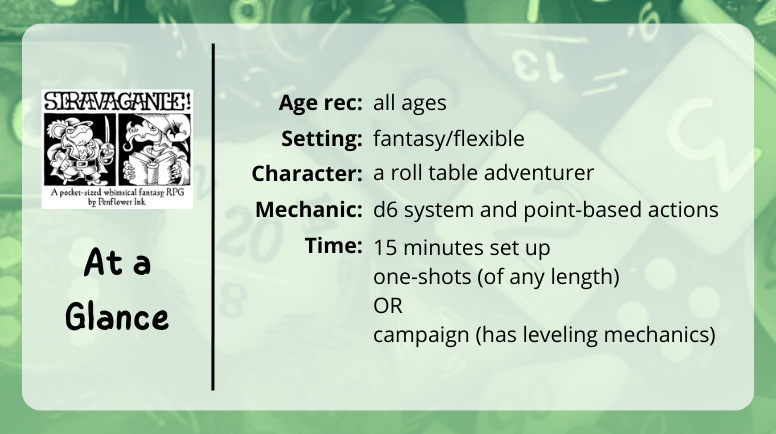Review of Stravagante!
Jump to:

Age target for Stravagante! – all ages (counting to 6 and some reading required)
Stravagante! is a TTRPG that can work for all ages as long as players are able to read their character sheet (requires tracking of 12-17 traits, abilities, and gear) or get help from another player and can recognize numbers up to 6, they should be able to handle the mechanics.
For the content, Stravagante! is a system that you can make stories for, so you’re able to tailor it towards your player’s particular needs and interests. The pre-made example adventure setting is pretty PG, and there is even a mechanic in the game that actively reduces one of your character stats if a player character willfully harms or kills an NPC, so it is built to encourage a more social game or defense based fighting versus stories built on primarily combat.

Setting for Stravagante!
Stravagante! is a system, but it also does come with a pre-made adventure and lots of very cool roll tables to help you with creating a place to hold all your adventures! It’s a good foundation for creating your own quests and worlds with some help from prompts, and the game does come with it’s own example setting in a pamphlet style printout that you can use to start.
The sample adventure, roll tables, and the general feel of the game’s artwork lean a bit towards whimsical medieval fantasy vibes, however, I could see this easily being used for other types of stories ranging from modern day fantasy worlds to sci-fi by just changing the way you ultimately interpret your prompt for that new genre.

Your character in Stravagante!
Characters in Stravagante! are generated from roll tables, so it’s a mystery who you’ll be playing until you roll! The roll tables determine your Kin, Class, and Treasures. From there, you’ll also roll for your 4 stats and choose your Traits, Skills, Flubs, and Equipment.
Once this is all rolled and chosen, you are ready to go!
Because much of this is generated from roll tables, character creation was VERY fast and only took about 10 minutes to generate a pretty well defined PC. It was also interesting creating a character almost entirely through randomization instead of having the idea for the character ahead of time because it still allowed for a ton of creativity… and helped break kiddo out of his Spider-Man themed character run. We got to try out something new that we normally wouldn’t have and really enjoyed the process.

Mechanics in Stravagante!
As with all reviews, I can’t cover the full set of mechanics, but I’ll go through some of the highlights here!
Energy Points and Luck Rolls
Whenever you want to make an action that requires some kind of skill, you get to choose if you will spend the Energy Points (EP) associated with your 4 base stats OR if you’ll make a Luck Roll and let chance totally decide what happens.
With EP, you are guaranteed some level of success depending on how many points you spend on your action. This is a limited resource though, so you need to strategize on when to use these. If you make a Luck Roll, there’s a 50% chance of getting a failure, but there’s also a chance that you could get a success plus a bonus that you can’t earn from spending even your max EP.
I like that it gives the option to choose which one to go with – there’s a lot of extra strategy and resource management built into the game by just allowing the option between these two easy to understand mechanics.

The Toll of Battle
I mentioned in the age target section of this review that the game has a penalty for players who willfully harm or kill NPCs in the game. Every time a PC does this, their sociability stat is reduced. This means that it’s going to be a lot harder for them to interact with others and get help.
There’s two ways players can go with using this. One is to hold back and make sure to only use combat for defense or try to talk through problems to keep their total stats as high as possible and not incur the penalty. The other route is to create a very dark knight lone wolf type character who maxes out everything else and forfeits playing a social game at all.
Both require acknowledgement of the fact that harming others makes it more difficult to interact with the world and gain benefits from assistance, so regardless of the path taken, it reinforces some social lessons that kids can pick up on. It’s also a simple mechanic to prevent or reign in murderhobos and it isn’t something I’ve seen much of before. I like this single sentence in the rules quite a bit and think it was a concise and brilliant way to set the tone for the game.
Overall thoughts on Stravagante!
I really liked this game – it was quick to read and easy to understand, the table provide lots of fuel for creating some awesome characters and adventures, and I appreciate the different printable formats that it came in. It’s great for one shots or campaigns and feels accessible to both new and veteran TTRPG players. We had fun with it, and I hope you do too!

Find a copy of Stravagante!
You can find a copy of Stravagante! on itchio!
If you liked this post, make sure to subscribe to the TTRPGkids monthly newsletter to stay up to date on the latest reviews, tips and tricks, game and podcast list updates, and more! Thank you for playing tabletop RPGs with your kids and sharing this awesome hobby with the next generation!


